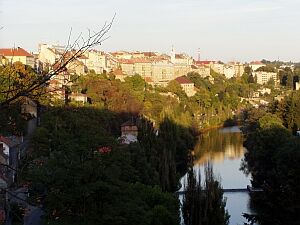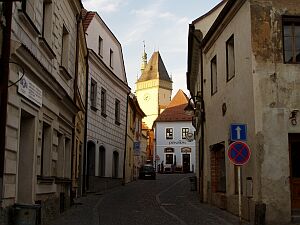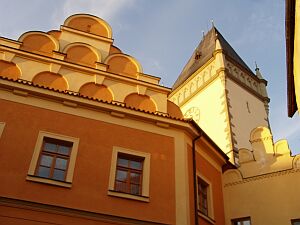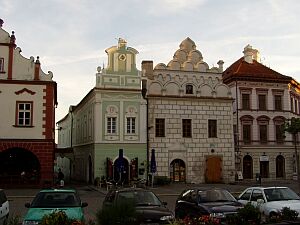Official Name
Tábor. For historical reasons, there is no German version of the name. Tábor simply means Camp. The reason for this name is quite clear when you see the history of town.
Location

| ||
| Tábor |
Tábor is located only 80 km south of →Prague in a mountainous area. The town straddles the small Lužnice river, which is just another Vltava tributary.
Population
Around 37,000 inhabitants.
Orientation
Tábor is rather small, which is due to the location. In the south, it's the deep valley of Lužnice river, in the north it's the lake Jordán that narrowed the city's development. The Staré Město (Old Town) sits atop a small spur and is only connected to the surroundings by a narrow stretch in the East. Furthermore, the Old Town is protected by a large wall. In medieval times, Tábor was almost impossible to seize.

| ||
| View from the Old Town to the river and New Town |
The Podhradí (Castle downtown) spreads in the western part of the city below the Old Town. Since there's no more space in the Old Town, Tábor developed to the east and partially to the north. The main train station is quite far away from the centre in the east of Tábor - it takes more than 15 minutes on foot to get to the Old Town. As soon as you enter the Old Town, it makes you feel like having left the modern world.
History
Compared to other cities in the Czech republic, Tábor is quite young. It was founded around the year 1420 by the Hussites and was supposed to be a bulwark against catholic dominated areas and their strongholds, such as →České Budějovice (Budweis) in the south-west. Therefore, only members of the Hussite movement were allowed to settle in Tábor. It was a strictly community spirit orientated place not allwoing personal property. Thus, all newcomers had to give away their personal belongings at the city gate.

| ||
| Inside the Old Town (in the middle: Pension Alfa) |
Thanks to its location, it was virtually impossible to capture the town by force. Additonally, a 14 km long tunnel network had been dug down into the underground. The Hussites were finally defeated and most of Bohemia was brought back to catholicism. Nevertheless Tábor was not destroyed at all. Au contraire - the Old City remained as it was 500 years ago, just as if the last centuries simply haven't taken place in Tábor.
Getting there / transportation
It takes less than 1½ hours from →Prag Hl. n. by train - the fare for a single ticket is around 60 Kč. When coming from Vienna (Franz-Joseph-station), it's necessary to change trains in Gmünd at the border. It takes around 4 hrs, the full fare is € 31, reduced € 21.
Several trains a day head for →České Budějovice (Budweis) in the south-west. It takes slightly more than one hour (46 Kč). For destinations east of Tabór, e.g. Telč, it's better to take the bus, since train connections are poor. The bus terminal is left of the train station.
As mentioned above, entering the Old Town means to step back in time for almost half a millenium. The Old Town consists of an intricate maze of cobbled lanes with exclusively very old houses lining up, skirted by a strong fortification system. And - almost no tourists at all! The centre of town is marked by the Žižkovo náměstí (Žižka square). Jan Žižka was the military commander of the Hussite movement, who fought the catholic army with great success. Therefore a square and a monument was dedicated to him (for a picture of the monument, see →History of the Czech republic).

| ||
| A typical sight in the Old Town of Tábor |
Around the same square, the old city hall houses the Husitské muzeum (Hussite museum) offering plenty of firsthand information about the Hussite movement and its fate. Next to the museum is the tourist information, which is quite helpful when you're looking for accommodation.
Another building facing the central square is the what-a-long-name Děkansky kostel Proměněni Páně na horě Tábor (Dean's church of the transfiguration of Christ on Mt. Tabor. This church offers an interesting mixture of gothic, baroque and renaissance details and was built in the 15th century. The tower was added in 1677.

| ||
| Old houses around Zizka square |
The south-west corner of the Old Town is dominated by Kotnov Hrad (Kotonov castle) housing another museum on the Hussite movement. Wide parts of the castle are under reconstruction (as of 2004). The western tip of the centre with the Klášterní kostel narození Panny Marie (Monastic church of Mary's birth), a beautiful gate and an old tower are worth a visit as well. Basically, it's best to simply stroll around the lanes and enjoy the marvellous townscape of Tábor.
The tourist information at the central square can arrange accommodation, mostly pensions or private rooms. Pension Alfa is only 100 m away from Zizka square to the west. There's a rustic bar in the ground floor, the rooms are nice and quite modern. 400 Kč incl. breakfast (without it's 350) for a bed in a double room is good value. The manager speaks English. There are some hotels between the train station and Old City - all of them considerably more expensive than a room in a pension. Address: Klokotská 107, Tel.: (0361)-25 61 65. Just around the corner to the right, the marvellous Bohemian restaurant Meluzina, incl. a cocktail bar, is definitely worth a try (as a matter of fact, it seems to be the best in town).
- http://www.tabor.cz/ Tabor's official website - includes an English version.
Do you have or do you know a good website about Tábor? Don't hesitate, let me know! After checking it, I would love to add it to the link list. You can submit a link by using the →contact form. Note that commercial websites will be treated differently.
©2024 Europe-East.com

 Albania
Albania Czech Republic
Czech Republic